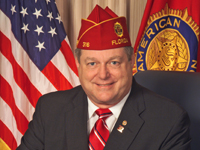
The message behind the new media
Last October, when U.S. soldiers from Bravo Troop 361 Cavalry were ambushed and forced to call an air strike on their own position in a remote corner of Afghanistan, they lost every personal possession they owned. Eight of them lost their lives. One disheartened sergeant sent an e-mail that soon appeared on The American Legion’s blog site, The Burn Pit: “Most people back home don’t even know ... no one gives a s**t.”
Legionnaires rushed to prove otherwise. They uploaded photos to the Internet of members holding up signs proclaiming, “We give a s**t.” More than $150,000 in merchandise, gift cards and laptop computers were soon on their way to the displaced troops.
This February, Operation Comfort Warriors – the Legion’s marquee program to provide comfort items for troops recovering at DoD hospitals – took first place among 729 competitors in the Pepsi Refresh Everything grant competition. Legion members and friends voted online throughout the month and, by winning, secured a $250,000 grant – money that is being used now to improve the lives of our wounded and their families.
These are just two examples among hundreds of why, throughout my year as national commander, I have emphasized the importance of dynamic electronic communication. This year, The American Legion vaulted into a new dimension of high-speed, multichanneled message transmission. Twitter and Facebook became part of our daily routine. The main Legion Web site tripled in visitation. The American Legion Online Update e-newsletter more than doubled in subscribers. Many Legion activities, from the Baseball World Series to the national convention, are now broadcast live on the Web. MyLegion.org, a social network that connects members, posts, departments and National Headquarters like never before, is the latest development. As I write this message, an American Legion mobile-phone app is being rolled out.
Changes are happening fast in the way we express The American Legion story and share it with others. In recent months, we have posted video interviews with World War II submariners, covered the Mojave Desert Cross ruling in the Supreme Court and followed the Freedom Car’s races. We have promoted veteran job fairs, raised funds, covered Capitol Hill, and posted hundreds of original photos and videos.
Between 75 and 100 fresh Legion stories have been posted each month. We have shown Web visitors how – and, more importantly, why – they should be a part of it all. Each of my official department visits is reported, with photos, on my blog site. The Legiontown USA site, meanwhile, has enabled local posts everywhere to share their outstanding stories online. Many more Web-based innovations are scheduled to appear soon.
The message, however, is not the medium. The message is us – what we do, who we are, the values we share. A group of soldiers from Fort Carson, Colo., received that message last fall. Wounded warriors from Walter Reed to Fort Lewis received that message after we received the Pepsi grant. Some 350,000 Web users a month are receiving it daily. Now, as communications technology continues to evolve, it is up to us, from National Headquarters to the smallest post, to always have a message to send. You never know when some war-weary soldier half a world away is sitting at a computer looking for someone who cares.
